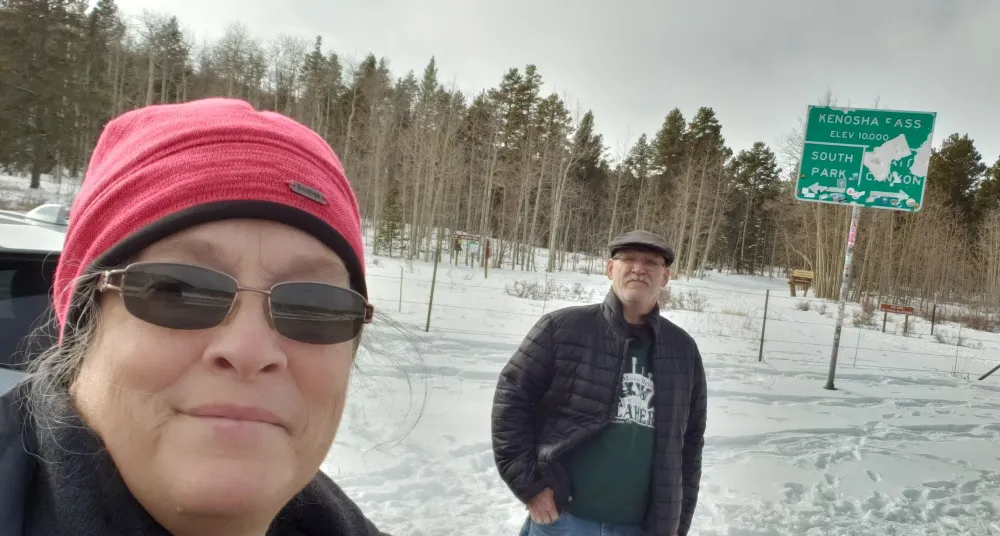 On Kenosha Pass, our very first adventure after moving to Colorado.
On Kenosha Pass, our very first adventure after moving to Colorado.
The very first trip Scott and I made after arriving in Colorado Springs was a Mountain Pass, Kenosha Pass 10,000 ft (3,000 m) to be exact. We had only experienced a real, Colorado Pass the previous July when we visited. Cucharas Pass is 9,995 feet (approximately 3046 m) and looking back now, it doesn’t seem impressive at all, or was it and we just did not know what we were experiencing? Since we have moved to this state we have found amazing passes that we just love going over!
In the state of Colorado, you will find 166 mountain passes over 7,783 feet (2,372 m). Of those passes, 107 are actually drivable; however, there are only 61 of those that are asphalt while the rest are either gravel or unimproved. Of the 61 roads that are drivable with a modern car (meaning low clearance and not a 4×4), 30 of them are over 10,000 ft (3048 m). Stat wise, this is a very collectible project.
What Exactly Is A Pass?
 Early morning arrival on LaVeta Pass.
Early morning arrival on LaVeta Pass.
Vocabulary.com defines a mountain pass as: “the location in a range of mountains of a geological formation that is lower than the surrounding peaks.” Simply put they are just places where two mountains come together. I have heard the terms gap, notch, saddle, and pass used to describe the easiest area to get over the mountains. We experienced some in Oklahoma, Arkansas, and even Texas, but they were nowhere near as impressive as the passes we have crossed over in Colorado.
I have watched video after video of people driving over mountain passes like Loveland Pass, Imogene Pass, and Black Bear Pass. What I remember most was that these things were massive and could be rather intimidating. What I am learning though, as we travel more and experience the many different passes here in Colorado, is that passes can be intense, but they can also be nothing more than a slight “hill”; at least, they may only feel that way. This has helped me to actually look forward to going over the many passes we have left to collect.
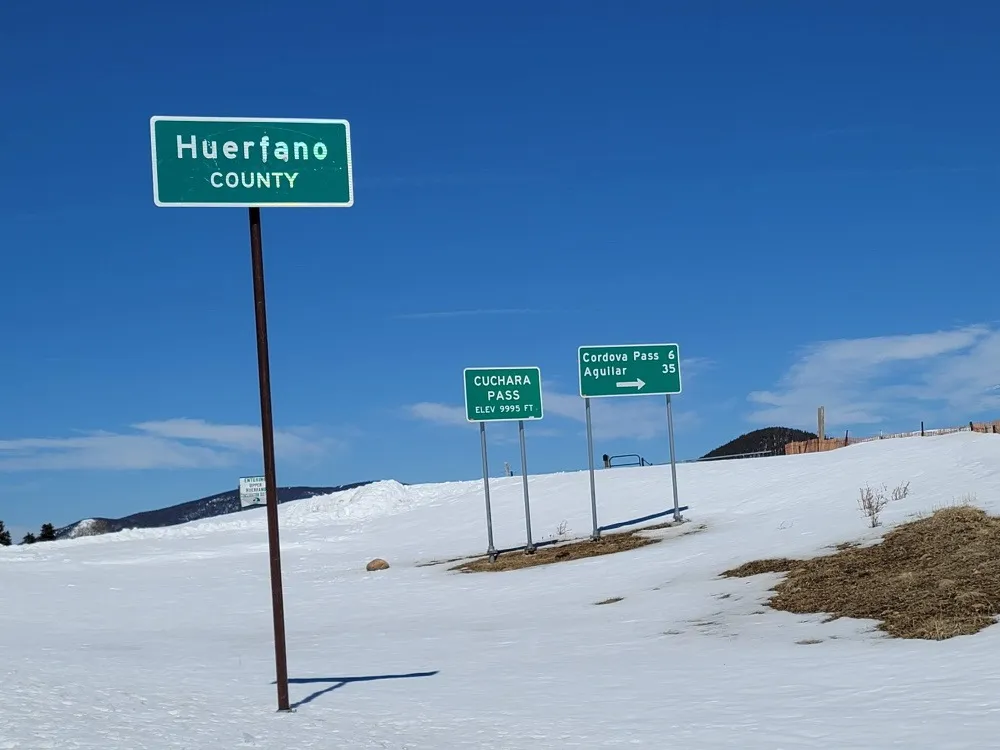 On Cuchara Pass on the Highway of Legends (Highway 12 Colorado
On Cuchara Pass on the Highway of Legends (Highway 12 Colorado
Often the mountain pass has a “plateau” of sorts and buildings and rest areas are sometimes placed there. These are also places where boundaries or borders are found such as the county line between Huerfano and Las Animas. Here you find the Cucharas Pass and just six miles from Cordova Pass that is also a dividing line between the two counties. This is not just a county border thing either, there are countries that have their borders meeting along mountain passes much like Chile and Argentina. The border between them runs along the Andes Mountain range and has many border crossings; over 42 passes.
Are Passes Really THAT Scary?
When we first started talking about collecting counties, we knew there were going to be roads that would intimidate us. For me the roads that were steep and winding caused me to freak out. I remember our first time driving the Talimena Drive between Oklahoma and Arkansas. We had watched many videos to help us figure out how to descend a mountain and it really made me nervous; I wasn’t even pulling a trailer! I was so worried about burning out my breaks that my nerves were shot by the time we arrived on flat roads. The highest elevation we reached that trip was 2,681 feet; this was nothing compared to the many passes here we have driven that are over 10,000 feet since moving to Colorado.
There are many reasons people are worried about mountain passes. Passes can have steep grades, sharp turns, and dangerous drop-offs. Many people who drive on the Colorado roads have never driven on anything but straight flat roads; their inexperience can be dangerous and frustrating. There is something shocking about the yellow signs with a semi-truck pointing downwards or tipping over when you reach the top of a pass. It can be intimidating and worrisome; however, keeping one’s mind on the road and driving over the passes a few times, they are no more scary than any other highway.
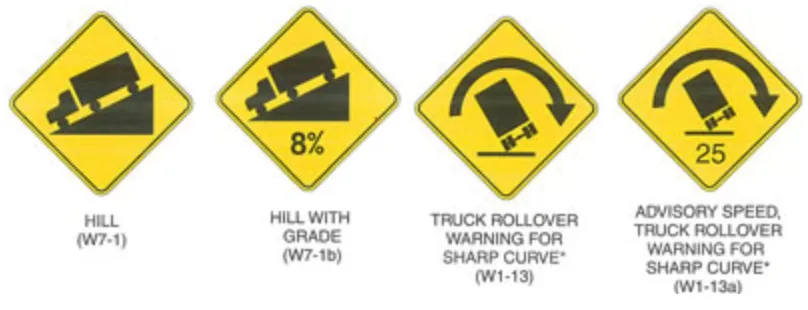 Road sign images and explanations found HERE at the US Department of Transportation website.
Road sign images and explanations found HERE at the US Department of Transportation website.
Why Are Mountain Roads So Steep and Twisty?
While looking up information on mountain passes, a specific question kept showing up, “Why are mountain roads so steep and twisty? Why can’t they just be made to go straight up and over?” I found answers to this question in a couple of places. Let’s look at the first part of the question. “Why are the roads so steep?”
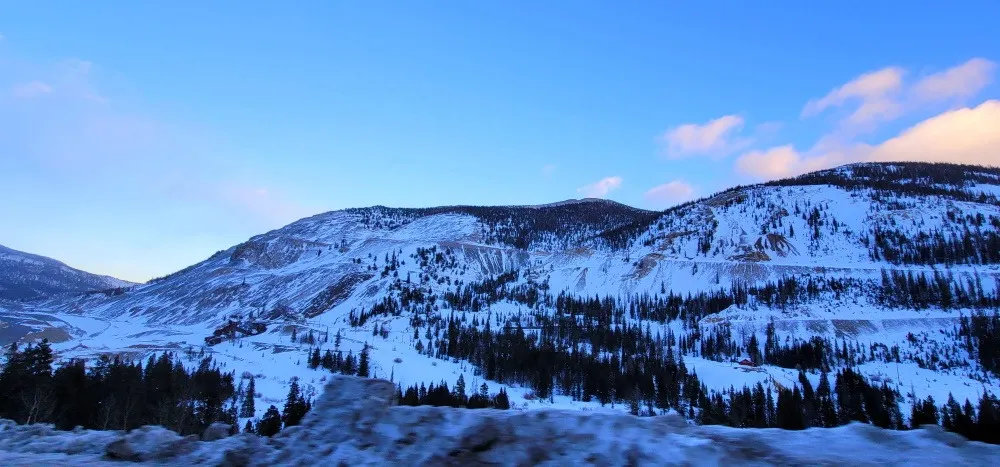 Heading up Red Mountain Pass the road is steep and twisty.
Heading up Red Mountain Pass the road is steep and twisty.
Roads follow the lay of the land. If you are driving in parts of East Colorado, you will basically be driving on flat, straight roads because that is how the land lays. Highway 70 from the Kansas border to Denver is a great example of this. You may have a few rolling hills because it is a prairie, but the land is fairly flat and the road follows this. However, Highway 70 from Denver to Grand Junction goes over mountains and into valleys. The road placement is determined by the slope of the mountains and, therefore, determines the “grade” or rate of climb/descent of the road causing this section of the highway to have steep climbs and many curves.
Open Oregon Educational Resources explained this rather well in their article “Assessing Slope of the Land“. They defined the slope to be the “incline of the land”. The land surveying has a math formula to help them know what the incline will be and then are able to give the appropriate warnings for drivers to use when traveling these areas. It is all extremely technical and if you would like to review the article, please feel free to do so by clicking the article title previously mentioned.
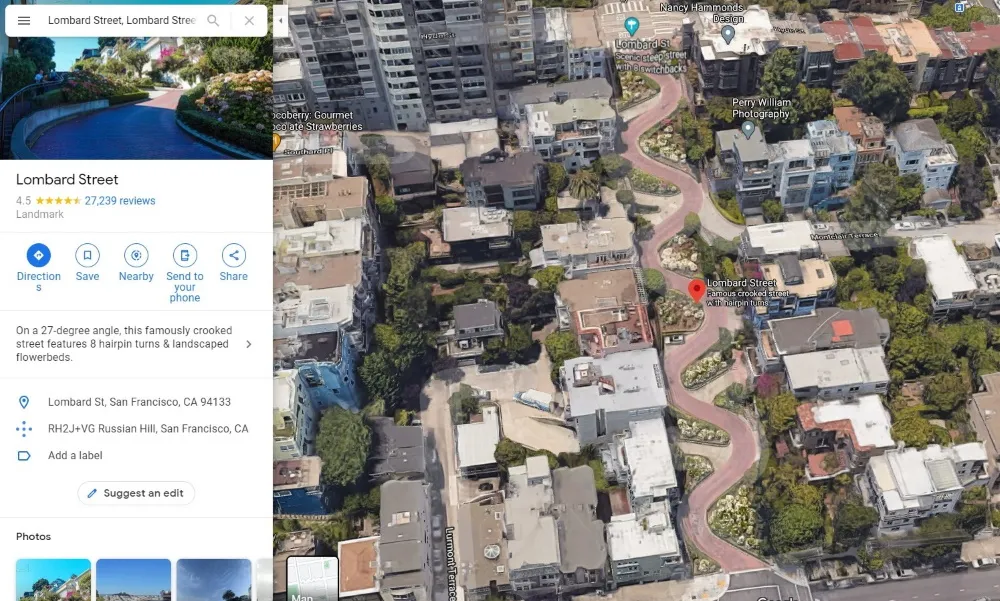 Screenshot taken from Google Maps to show an example of hairpin turns.
Screenshot taken from Google Maps to show an example of hairpin turns.
The slope and lay of the land also determine why roads have so many curves to them; however, not all curves are created because of this. Often steep roads will have what is called “hairpin” or “switchback” turns to help a driver climb a mountain in a short amount of space. These types of turns are usually steep and have sharp turns. One of the most famous roads in the United States that shows this extreme elevation change in less than half a quarter of a mile is Lombard Street in San Francisco, California. True the elevation change is not as extreme as in the mountains, however, the fact that the distance is so short from top to bottom, the grade is 27%, making this a very interesting drive.
Most roads in Colorado are not close to this extreme. On the passes here, you will mostly find grades of 6-9%, rarely anything more. However, you will occasionally find a few roads with more of an incline, but rarely on the main highways. These switchbacks help vehicles climb to the top of the mountains using less energy and providing safety as well. Between snow, ice, rain, and wind, the weather conditions can cause roads to be dangerous so everything that can be done to help drivers be safe is well worth it.
Safety On The Passes
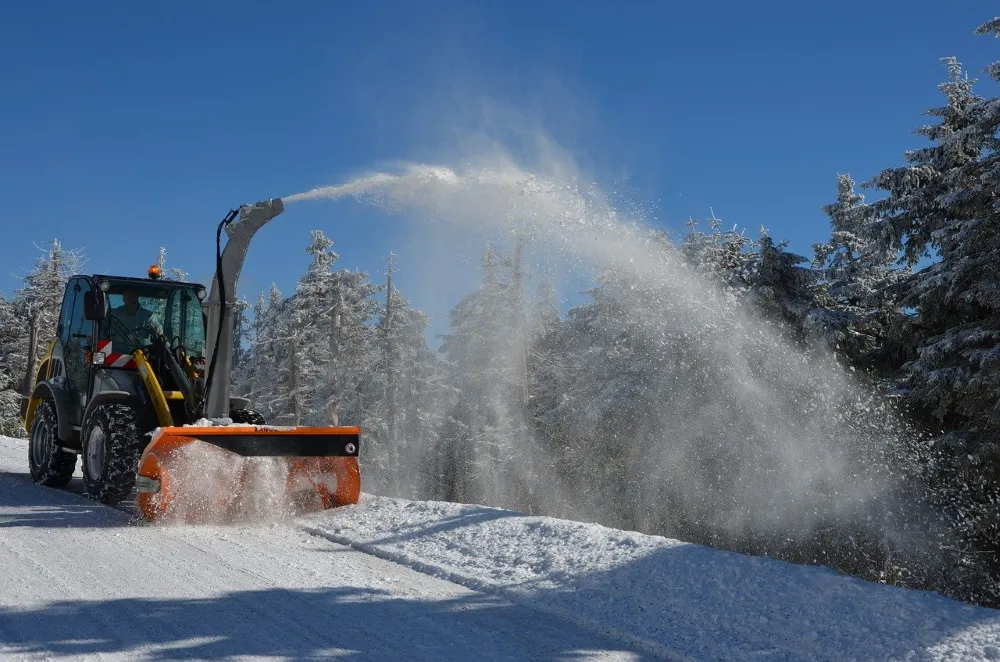 Could not find our snowplow images so… Image by Pixaline from Pixabay
Could not find our snowplow images so… Image by Pixaline from Pixabay
Mountain passes can be dangerous, but with the help of the Colorado Department of Transportation (CoDoT) and a few safety precautions, the experience can be rewarding and successful. Before we get into our car, we make sure we have the correct safety equipment for the road depending upon the weather we will experience. This means we have good tires, our snow cables for the tires, and we know what the weather conditions are for the area we are traveling. We will pull up the traffic information for the highways we are planning to drive and make sure we have clear alternative routes if needed. CoDoT has a variety of tools on their website that can assist us on our travel and we use those tools often.
One of the things we love about Colorado is that CoDoT is very good about getting roads cleared as soon as possible. This goes for the normal everyday roads and the passes alike. If winter weather storms have been predicted, they are out as soon as possible to start the de-icing and then they begin to plow as soon as possible. We have found the passes easy and safe to traverse, but we are still careful.
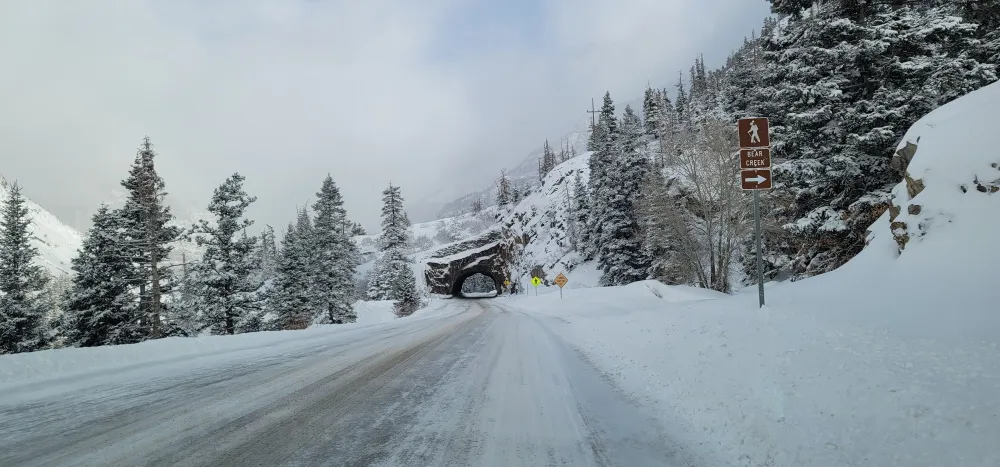 The Bear Creek Tunnel on the Million Dollar Highway; one of the most dangerous roads in the United States.
The Bear Creek Tunnel on the Million Dollar Highway; one of the most dangerous roads in the United States.
There are a few things that have to happen when driving the passes that are important to do to keep yourself and others safe. One is to know how to drive up and down these roads.
Driving Up The Mountain
- Always have your vehicle in good working order. Be sure the brakes, windshield wipers, and tires are in good condition. Watch the fluids in your car to make sure the engine does not overheat.
- What may seem like a strange thing to do, but during the summer months you will want to turn off your air conditioner. This will help keep the engine from over heating, plus the temprature on many mountain passes will be much cooler than you expect.
- If there are two lanes or passing lanes as you are driving up the mountain, make sure to stay in the right lane unless passing; this is law in most states now. It will keep traffic from backing up and prevent road rage in other drivers who will insist on passing you on the right.
- However, if there are only two lanes of traffic, keep an eye on the number of cars behind you. If you are impeding traffic, find a turn-out and allow the other drivers to pass. This will help keep people from taking unnecessary chances passing you at the wrong times because they are frustrated.
- Slow down! Do not try to race to the top of the mountain, it will still be there no matter how slow you take it. Too often people are in a hurry to get where they are going and they make mistakes. This in itself could cause an accident or worse if you take a turn too quickly.
Arriving on the Pass
- Once you have reached the top of the pass, there are often places to park, trailheads, or scenic overlooks. Take advantage of those areas to get out of your vehicle. You probably need to walk around or stretch. If there are not any of these, prepare to drive down the pass.
Driving Down The Mountain
- If you are in a vehicle with engine brakes, you should use them. These will help the engine to slow you down, you will only need to “tap” your breaks if you accelerate faster than you need to be traveling.
- Use the lower gears of your vehicle. If you have an automatic engine, there is a “manual” setting or an L1, L2, L3. Use those if the grade is large. Then you will only need to “tap” your breaks occasionally to slow you down.
- Do NOT “ride” your breaks. The goal is to proceed down the pass without burning your breaks. Once the breaks get hot, they will not stop. As you accelerate, gently apply your breaks for short periods, being in the lower gears will help the engine slow your vehicle down giving you better control and less need for the breaks.
- It is suggested a driver not go any faster down the pass than what they were doing up the pass. If you are going slower than other people, stay to the right. Not only is it curtious, it is law in many states.
Why Are There Ski Jumps Next To The Highway?
 Runaway Truck Ramp has saved many lives, even this one.
Runaway Truck Ramp has saved many lives, even this one.
As we drove down Monarch Pass, we saw what looked like a ski jump at the side of the road. These are special safety ramps to help trucks, and other vehicles, who have lost their brakes due to them getting too hot. These runaway truck ramps have saved lives, but what exactly are they?
This specific truck ramp we saw on highway 50 on the west side of the Monarch Pass is designed to slow the truck by going up the ramp. If it does not slow it down by gravity, there are many lines of barrels filled with gravel and sand to bring it to a halt. This is just one of many types of runaway ramps. Some are a lot longer and some have the "road" filled with gravel to help the wheels of the truck come to a stop. They all do the same thing, stop a runaway truck that has lost its brakes.
The video is from 9News in Denver, Colorado.
If you would like to see their YouTube channel please click HERE
In this video, we see a report from Channel 9 News out of Denver about a truck that used the ramp. The driver's brakes failed and the ramp was there just in time to help save lives. You are able to see the smoke coming from the truck and then he masterfully entered the ramp and was able to stop. These are great safety opportunities for truckers. You can read more on Runaway Truck Ramps by clicking HERE.
How Many Passes In Colorado Have We Collected?
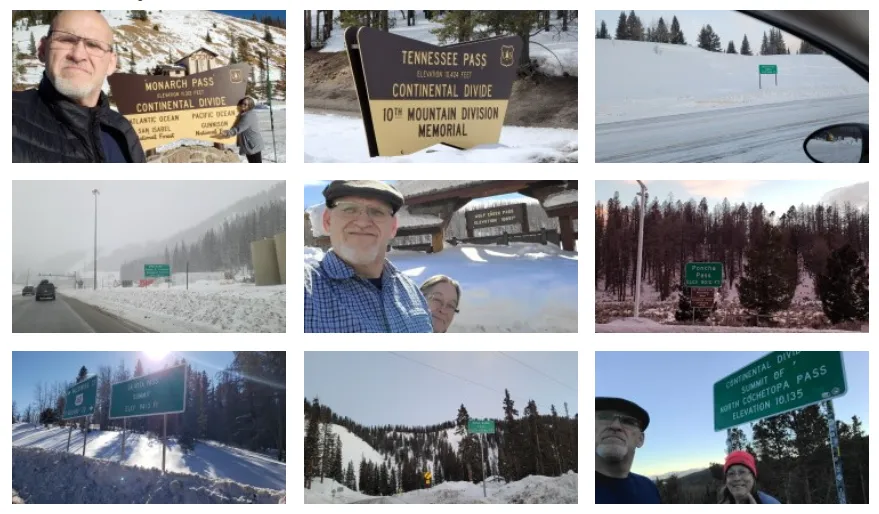 Only a few images of the passes we have crossed in Colorado.
Only a few images of the passes we have crossed in Colorado.
Out of the 79 Colorado mountain passes and highway summits that can be driven because of improved roads we have crossed 30 of them. We go over Ute Pass (9,165 feet - 2,793 m) in Divide many times because we tend to drive Colorado highway 24 often to get to Florissant Fossil Beds National Monument. While the highest pass we have crossed is through the Eisenhower Tunnel (11,158 feet - 3,401 m) on Colorado Highway 70.
One of the most special passes for me in this state is Wolf Creek Pass. One of my favorite uncles was my dad's brother Uncle Bruce. He was a wall of a man who stayed with us when I was little and my three children loved him as well, especially when he would ask them if they wanted donuts and then thump them on the arm saying, "Hurts Donut!" Sure wish he could have experienced the Hurts Donuts shops around the country. This man was a Vietnam Veteran who received two Purple Hearts, the Silver Star, the Bronze Star, and the Cross of Gallantry. My uncle worked for the Colorado Department of Transportation as one of the snowplow drivers for Wolf Creek Pass, and he was a hero there as well. He saved a woman and her family from a snowbank and was given a commendation from the state of Colorado.
The Passes We Have Crossed



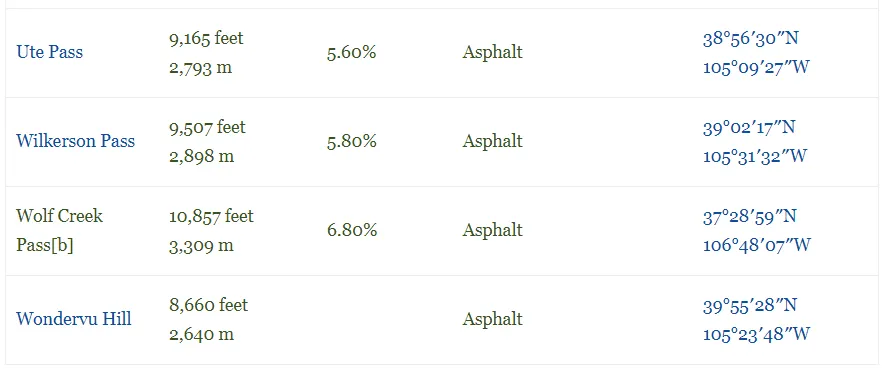
And Like All Passes, We Must Move On To The Next
Passes are amazing structures of engineering. They take planning, math, and a lot of work hours. There are many people who work hard to provide safe passage over these elevated passes and we thank them for their hard work. I know I enjoy experiencing each of these passes and I can't wait to cross over as many as possible while we explore the state of Colorado.
Thank you so much for joining us. We do appreciate each of you who take the time to read our posts. It means so much to us. Please remember to Get Out, Live Life Outside Your Box; you know we are.




